The global AI-powered in-car assistant market is valued at USD 1 billion in 2025 and is slated to reach USD 5.1 billion by 2035, recording an absolute increase of USD 4 billion over the forecast period. This translates into a total growth of 401.5%, with the market forecast to expand at a compound annual growth rate (CAGR) of 17.5% between 2025 and 2035. The overall market size is expected to grow by approximately 5.02X during the same period, supported by increasing demand for connected vehicle technologies, growing adoption of voice-activated systems across automotive applications, and rising preference for enhanced driver assistance solutions across OEM and aftermarket channels.
The AI-powered in-car assistant market represents an emerging segment of the global automotive electronics industry, characterized by rapid technological advancement and evolving consumer expectations across vehicle cockpit applications. Market dynamics are influenced by changing mobility patterns, growing integration of artificial intelligence technologies, and expanding connectivity infrastructure in smart vehicle ecosystems. Traditional automotive interfaces are transforming as consumers seek intelligent, voice-controlled systems that offer enhanced convenience and natural interaction capabilities.
Consumer behavior in the AI-powered in-car assistant market reflects broader trends toward connected mobility solutions that provide both operational convenience and perceived safety benefits. The market benefits from the growing integration of smart vehicle technologies, which are recognized for their potential to improve driver experience and reduce distraction while driving. Additionally, the versatility of AI-powered assistants as both navigation aids and infotainment controllers supports sustained demand across multiple vehicle categories and usage scenarios.
Regional adoption patterns vary significantly, with North American and European markets showing strong preference for advanced voice control systems, while Asian markets demonstrate increasing integration of localized AI technologies alongside global automotive platforms. The automotive landscape continues to evolve with premium and luxury vehicle manufacturers leading implementation of sophisticated assistant technologies, reflecting consumer willingness to pay higher prices for enhanced digital experiences and connectivity features.
The competitive environment features established technology companies alongside emerging automotive AI specialists that focus on natural language processing and machine learning capabilities. Software development efficiency and hardware integration remain critical factors for market participants, particularly as processing requirements and connectivity standards continue to advance. Implementation strategies increasingly emphasize multi-platform approaches that combine cloud-based processing with edge computing capabilities for real-time response optimization.
Market consolidation trends indicate that larger automotive suppliers are acquiring AI technology companies to diversify their digital capabilities and access next-generation assistant platforms. OEM partnerships have gained momentum as vehicle manufacturers seek to differentiate their offerings while maintaining competitive feature development timelines. The emergence of personalized assistant configurations, including driver-specific voice recognition and contextual awareness features, reflects changing consumer priorities and creates new market opportunities for innovative technology providers. Manufacturing integration and quality assurance improvements enable consistent deployment scaling while maintaining the advanced functionality characteristics that consumers expect from premium automotive AI systems.
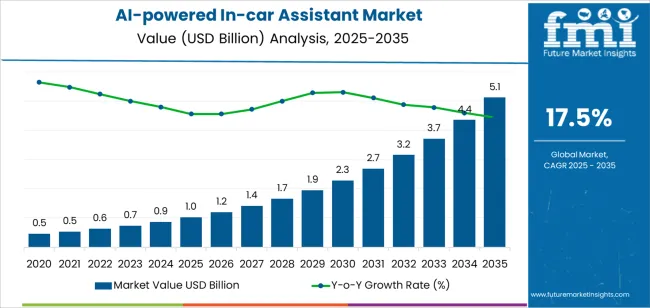
Between 2025 and 2030, the AI-powered in-car assistant market is projected to expand from USD 1 billion to USD 2.2 billion, representing a 30.9% share of the total forecast growth for the decade. This phase of development will be shaped by increasing adoption of premium vehicle technologies, rising demand for connected mobility solutions, and growing emphasis on natural language processing capabilities with enhanced conversational functionality. Automotive manufacturers are expanding their development capabilities to address the growing demand for integrated AI systems, voice-activated controls, and personalized assistant features across vehicle platforms.
| Metric | Value |
|---|---|
| Estimated Value (2025E) | USD 1 billion |
| Forecast Value (2035F) | USD 5.1 billion |
| Forecast CAGR (2025–2035) | 17.50% |
From 2030 to 2035, the market is forecast to grow from USD 2.2 billion to USD 5.1 billion, adding another USD 2.8 billion, which constitutes 69.1% of the overall ten-year expansion. This period is expected to be characterized by the expansion of advanced AI capabilities, the integration of multi-modal interaction systems, and the development of context-aware assistant technologies with enhanced personalization and predictive functionality. The growing adoption of machine learning algorithms will drive demand for AI-powered assistants with superior conversational abilities and compatibility with autonomous driving technologies across automotive applications.
Between 2020 and 2025, the AI-powered in-car assistant market experienced accelerated growth, driven by increasing demand for connected vehicle features and growing recognition of voice control systems as essential components for modern automotive experiences across personal and commercial vehicle applications. The market developed as consumers recognized the potential for AI assistant technologies to provide both convenience enhancement and safety benefits while enabling hands-free operation protocols. Technological advancement in natural language processing and cloud computing integration began emphasizing the critical importance of maintaining system responsiveness and accuracy in diverse driving environments.
Market expansion is being supported by the increasing global demand for connected vehicle technologies and the corresponding need for intelligent interaction solutions that can provide superior user experiences and operational efficiency while enabling hands-free control and enhanced safety across various automotive and mobility applications. Modern consumers and automotive industry specialists are increasingly focused on implementing advanced AI systems that can deliver natural conversation capabilities, minimize driver distraction, and provide consistent performance throughout complex vehicle integration scenarios and diverse operational environments. AI-powered assistants' proven ability to deliver exceptional user interaction against traditional control interfaces, enable convenient voice operation, and support intelligent vehicle management make them essential components for contemporary automotive and mobility operations.
The growing emphasis on connected mobility and intelligent vehicle systems is driving demand for AI-powered assistants that can support large-scale automotive implementations, improve driver assistance outcomes, and enable comprehensive vehicle control systems. Consumer preference for technologies that combine effective voice recognition with advanced AI capabilities and predictive functionality is creating opportunities for innovative assistant implementations. The rising influence of autonomous driving technologies and smart mobility trends is also contributing to increased demand for AI-powered assistants that can provide contextual awareness, intelligent decision support, and reliable performance across extended operational scenarios.
The AI-powered in-car assistant market is poised for rapid growth and transformation. As consumers across North America, Europe, Asia-Pacific, and emerging markets seek technologies that deliver exceptional interaction quality, natural conversation capabilities, and convenient vehicle control options, AI-powered assistants are gaining prominence not just as convenience features but as strategic enablers of intelligent mobility and enhanced driving experiences.
Rising connected vehicle adoption in Asia-Pacific and expanding smart mobility initiatives globally amplify demand, while manufacturers are leveraging innovations in machine learning systems, natural language processing technologies, and cloud integration platforms.
Pathways like advanced conversational AI, multi-modal interaction systems, and personalized assistant solutions promise strong margin uplift, especially in premium vehicle segments. Geographic expansion and technology diversification will capture volume, particularly where local language support and cultural adaptation are critical. Regulatory support around vehicle safety standards, data privacy requirements, and autonomous driving frameworks give structural support.
The market is segmented by type, application, integration level, vehicle segment, deployment mode, and region. By type, the market is divided into Conversational AI, Generative AI, Voice Recognition AI, and Others categories. By application, it covers OEMs & Tier-1s, Aftermarket, Fleet Management, and Ride-sharing Services segments. By integration level, the market includes Full Integration, Partial Integration, and Standalone solutions. By vehicle segment, it comprises Luxury Vehicles, Mid-range Vehicles, and Economy Vehicles. By deployment mode, the market is categorized into Cloud-based, Edge-based, and Hybrid categories. Regionally, the market is divided into North America, Europe, East Asia, South Asia & Pacific, Latin America, and the Middle East & Africa.
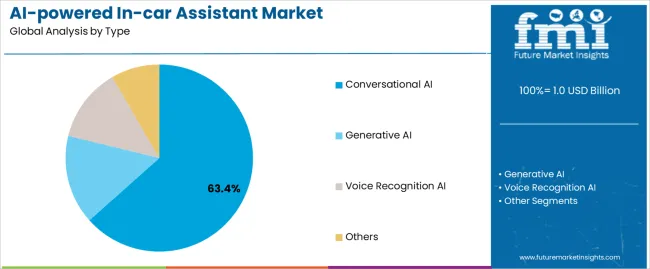
The conversational AI segment is projected to account for 63.4% of the AI-powered in-car assistant market in 2025, reaffirming its position as the leading type category. Automotive manufacturers and technology integrators increasingly utilize conversational AI technologies for their superior natural language processing capabilities when operating across diverse vehicle platforms, excellent contextual understanding properties, and widespread compatibility in applications ranging from navigation assistance to vehicle system control operations. Conversational AI technology's advanced machine learning algorithms and dialog management capabilities directly address the user requirements for natural interaction experiences in complex automotive environments.
This type segment forms the foundation of modern in-car assistant implementations, as it represents the technology with the greatest user acceptance and established market demand across multiple vehicle categories and consumer segments. Manufacturer investments in natural language processing and conversation optimization continue to strengthen adoption among automotive OEMs and technology partners. With consumers prioritizing natural interaction and voice control reliability, conversational AI aligns with both user preferences and safety expectations, making it the central component of comprehensive automotive AI strategies.
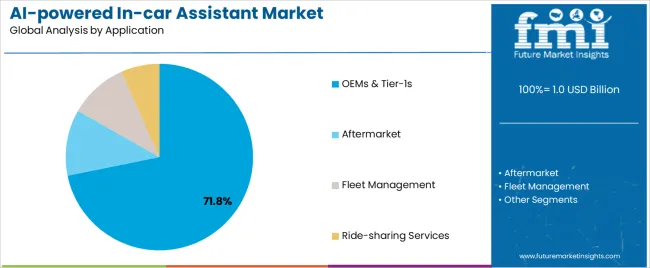
OEMs and Tier-1 supplier applications are projected to represent 71.8% of AI-powered in-car assistant demand in 2025, underscoring their critical role as the primary implementation channel for assistant technologies across vehicle manufacturing, system integration, and automotive supply chain applications. Automotive manufacturers prefer AI-powered assistants for their exceptional integration characteristics, scalable deployment options, and ability to enhance vehicle differentiation while ensuring consistent performance throughout diverse vehicle production scenarios. Positioned as essential components for modern vehicle platforms, AI-powered assistants offer both competitive advantage benefits and comprehensive user experience enhancement.
The segment is supported by continuous innovation in automotive integration technologies and the growing availability of specialized platforms that enable diverse vehicle implementations with enhanced functionality consistency and streamlined development capabilities. Additionally, OEMs and suppliers are investing in advanced AI technologies to support large-scale vehicle production and platform standardization. As connected vehicle requirements become more prevalent and user experience expectations increase, OEM and Tier-1 applications will continue to represent a major implementation market while supporting advanced automotive utilization and technology development strategies.
The AI-powered in-car assistant market is advancing rapidly due to increasing demand for connected vehicle technologies and growing adoption of intelligent interaction solutions that provide superior user experiences and safety benefits while enabling hands-free operation across diverse automotive and mobility applications. The market faces challenges, including complex integration requirements, data privacy concerns, and the need for specialized AI expertise and continuous algorithm optimization. Innovation in machine learning capabilities and cloud integration systems continues to influence product development and market expansion patterns.
The growing adoption of connected vehicle platforms, IoT integration initiatives, and intelligent transportation systems is enabling manufacturers to produce advanced AI assistant technologies with superior connectivity positioning, enhanced cloud integration, and comprehensive vehicle system compatibility. Advanced machine learning systems provide improved interaction accuracy while allowing more efficient processing workflows and reliable performance across various automotive applications and operational conditions. Manufacturers are increasingly recognizing the competitive advantages of AI assistant capabilities for market differentiation and premium positioning.
Modern AI assistant developers are incorporating sophisticated language understanding systems, context-aware processing capabilities, and predictive interaction technologies to enhance user engagement, enable natural conversation formats, and deliver intelligent responses to automotive customers. These technologies improve user satisfaction while enabling new market opportunities, including personalized experiences, predictive assistance, and enhanced voice control characteristics. Advanced AI integration also allows manufacturers to support comprehensive vehicle intelligence systems and market expansion beyond traditional voice command approaches.
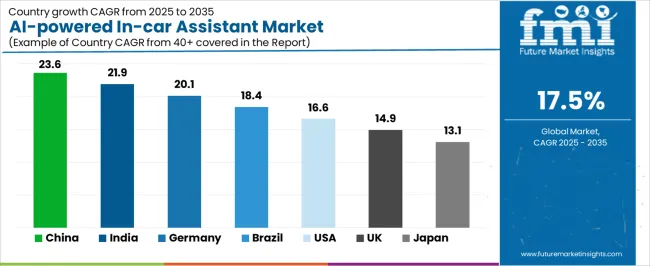
| Country | CAGR (2025–2035) |
|---|---|
| China | 23.6% |
| India | 21.9% |
| Germany | 20.1% |
| Brazil | 18.4% |
| United States (USA) | 16.6% |
| United Kingdom (UK) | 14.9% |
| Japan | 13.1% |
The AI-powered in-car assistant market is experiencing rapid growth globally, with China leading at a 23.6% CAGR through 2035, driven by aggressive adoption of smart vehicle technologies, massive investment in AI development programs, and significant expansion of connected mobility infrastructure. India follows at 21.9%, supported by growing automotive digitalization initiatives, expanding technology sector capabilities, and increasing consumer demand for advanced vehicle features. Germany shows growth at 20.1%, emphasizing automotive industry leadership and premium technology integration. Brazil records 18.4%, focusing on expanding automotive manufacturing capabilities and technology modernization. The USA demonstrates 16.6% growth, prioritizing advanced AI development and autonomous vehicle technologies. The UK exhibits 14.9% growth, emphasizing connected vehicle innovation and smart mobility development. Japan shows 13.1% growth, supported by automotive technology excellence and quality-focused implementation patterns.
The report covers an in-depth analysis of 40+ countries, the top-performing countries are highlighted below.
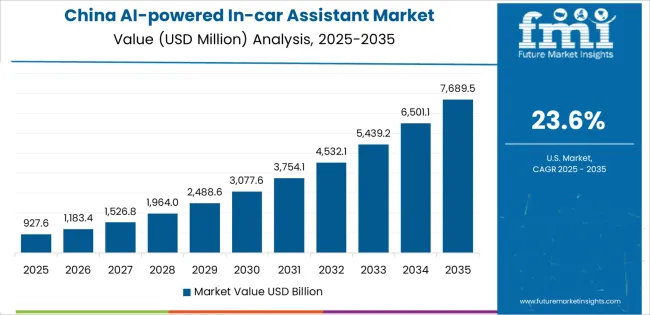
Revenue from AI-powered in-car assistants in China is projected to exhibit exceptional growth with a CAGR of 23.6% through 2035, driven by aggressive smart vehicle adoption and rapidly expanding AI technology investment supported by government initiatives promoting connected mobility development. The country's strong position in AI research and increasing investment in automotive technology infrastructure are creating substantial demand for intelligent vehicle systems. Major automotive manufacturers and technology companies are establishing comprehensive development capabilities to serve both domestic market demand and expanding export opportunities.
Revenue from AI-powered in-car assistants in India is expanding at a CAGR of 21.9%, supported by the country's growing automotive sector, expanding technology development capabilities, and increasing adoption of connected vehicle features. The country's initiatives promoting digital transformation and growing consumer awareness are driving requirements for intelligent automotive technologies. International suppliers and domestic manufacturers are establishing extensive development and production capabilities to address the growing demand for AI assistant systems.
Revenue from AI-powered in-car assistants in Germany is expanding at a CAGR of 20.1%, supported by the country's automotive industry leadership, strong emphasis on premium technology integration, and robust demand for advanced vehicle systems in luxury and high-end automotive applications. The nation's established automotive engineering sector and quality-focused operations are driving sophisticated assistant implementations throughout the automotive industry. Leading manufacturers and technology companies are investing extensively in AI development and integration technologies to serve both domestic and international markets.
Revenue from AI-powered in-car assistants in Brazil is growing at a CAGR of 18.4%, driven by the country's expanding automotive manufacturing sector, growing technology integration programs, and increasing investment in connected vehicle development. Brazil's large automotive market and commitment to technology advancement are supporting demand for intelligent vehicle solutions across multiple automotive segments. Manufacturers are establishing comprehensive development capabilities to serve the growing domestic market and expanding automotive technology opportunities.
Revenue from AI-powered in-car assistants in the USA is expanding at a CAGR of 16.6%, supported by the country's advanced AI technology sector, strategic focus on autonomous vehicle development, and established automotive innovation capabilities. The USA's technology leadership and premium automotive market integration are driving demand for sophisticated assistant technologies in luxury vehicles, autonomous systems, and premium mobility applications. Manufacturers are investing in comprehensive AI development to serve both domestic specialty markets and international premium applications.
Revenue from AI-powered in-car assistants in the UK is growing at a CAGR of 14.9%, driven by the country's focus on connected vehicle advancement, emphasis on mobility innovation, and strong position in automotive technology development. The UK's established automotive innovation capabilities and commitment to smart mobility solutions are supporting investment in AI assistant technologies throughout major automotive regions. Industry leaders are establishing comprehensive technology integration systems to serve domestic mobility requirements and premium automotive applications.
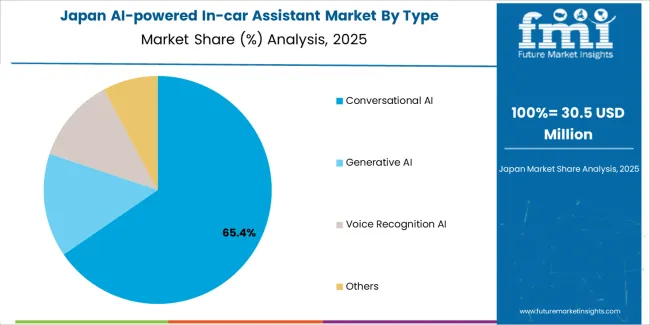
Revenue from AI-powered in-car assistants in Japan is expanding at a CAGR of 13.1%, supported by the country's automotive technology excellence, growing intelligent vehicle sector, and strategic emphasis on quality technology development. Japan's advanced automotive engineering capabilities and integrated technology systems are driving demand for high-quality assistant technologies in premium vehicles, luxury automotive applications, and advanced mobility systems. Leading manufacturers are investing in specialized capabilities to serve the stringent requirements of quality-focused automotive and premium mobility industries.
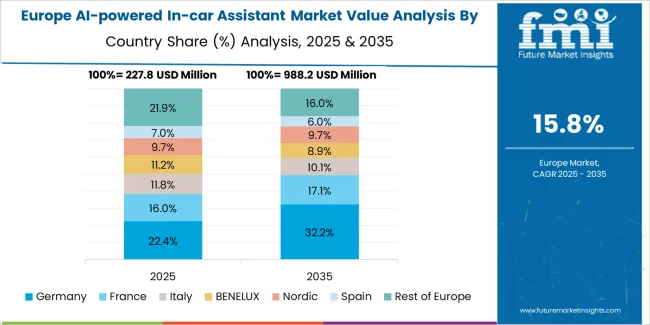
The AI-powered in-car assistant market in Europe is projected to grow from USD 204.1 million in 2025 to USD 1,023.9 million by 2035, registering a CAGR of 17.5% over the forecast period. Germany is expected to maintain its leadership position with a 42.3% market share in 2025, declining slightly to 41.8% by 2035, supported by its strong automotive industry leadership, sophisticated vehicle technology capabilities, and comprehensive automotive engineering infrastructure serving diverse AI assistant applications across Europe.
France follows with a 21.4% share in 2025, projected to reach 21.8% by 2035, driven by robust demand for premium vehicle technologies in automotive applications, connected mobility programs, and luxury vehicle markets, combined with established automotive manufacturing infrastructure and technology development expertise. The United Kingdom holds a 14.2% share in 2025, expected to reach 14.6% by 2035, supported by strong connected vehicle sector and growing premium automotive activities. Italy commands a 9.8% share in 2025, projected to reach 10.1% by 2035, while Spain accounts for 6.7% in 2025, expected to reach 6.9% by 2035. The Netherlands maintains a 3.1% share in 2025, growing to 3.2% by 2035. The Rest of Europe region, including Nordic countries, Eastern Europe, Belgium, Poland, and other nations, is anticipated to maintain momentum, with its collective share moving from 2.5% to 1.6% by 2035, attributed to increasing automotive technology adoption in Eastern Europe and growing connected vehicle penetration in Nordic countries implementing smart mobility programs.
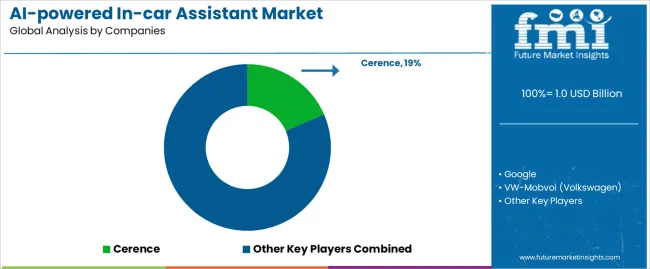
The AI-powered in-car assistant market is characterized by competition among established technology companies, automotive AI specialists, and integrated software platform providers. Companies are investing in machine learning research, natural language processing optimization, cloud integration system development, and comprehensive AI portfolios to deliver consistent, high-performance, and application-specific in-car assistant solutions. Innovation in conversational AI systems, multi-modal interaction integration, and user experience enhancement is central to strengthening market position and competitive advantage.
Cerence leads the market with a strong market share, offering comprehensive automotive AI solutions including advanced speech recognition and natural language processing systems with a focus on OEM and automotive integration applications. Google provides cloud-based AI platforms with an emphasis on comprehensive connectivity and integration capabilities. VW-Mobvoi delivers specialized automotive AI solutions with a focus on conversational interfaces and vehicle-specific applications. Stellantis offers integrated automotive platforms with emphasis on OEM implementation and fleet applications. TomTom focuses on navigation-integrated AI systems and location-aware assistant capabilities. Sensory provides embedded AI solutions with emphasis on edge processing and privacy-focused implementations.
| Item | Value |
|---|---|
| Quantitative Units | USD 1,020.6 million |
| Type | Conversational AI; Generative AI; Voice Recognition AI; Others |
| Application | OEMs & Tier-1s; Aftermarket; Fleet Management; Ride-sharing Services |
| Integration Level | Full Integration; Partial Integration; Standalone |
| Vehicle Segment | Luxury Vehicles; Mid-range Vehicles; Economy Vehicles |
| Deployment Mode | Cloud-based; Edge-based; Hybrid Mode |
| End-Use | Automotive Manufacturers; Technology Integrators; Fleet Sector Operators; Mobility Service Providers |
| Regions Covered | North America; Europe; East Asia; South Asia & Pacific; Latin America; Middle East & Africa |
| Countries Covered | China; India; Germany; Brazil; United States; United Kingdom; Japan; and 40+ additional countries |
| Key Companies Profiled | Cerence; Google; VW-Mobvoi; Stellantis; TomTom; Sensory |
| Additional Attributes | Dollar sales by type and application category; regional demand trends; competitive landscape; technological advancements in AI processing systems; cloud integration development; natural language processing innovation; automotive platform integration |
The global ai-powered in-car assistant market is estimated to be valued at USD 1.0 billion in 2025.
The market size for the ai-powered in-car assistant market is projected to reach USD 5.1 billion by 2035.
The ai-powered in-car assistant market is expected to grow at a 17.5% CAGR between 2025 and 2035.
The key product types in ai-powered in-car assistant market are conversational ai, generative ai, voice recognition ai and others.
In terms of application, oems & tier-1s segment to command 71.8% share in the ai-powered in-car assistant market in 2025.






Full Research Suite comprises of:
Market outlook & trends analysis
Interviews & case studies
Strategic recommendations
Vendor profiles & capabilities analysis
5-year forecasts
8 regions and 60+ country-level data splits
Market segment data splits
12 months of continuous data updates
DELIVERED AS:
PDF EXCEL ONLINE
Ceramide Skincare Market Size and Share Forecast Outlook 2025 to 2035
Antioxidant Skincare Market Size and Share Forecast Outlook 2025 to 2035
Customized Skincare Market Size and Share Forecast Outlook 2025 to 2035
Rice Water Skincare Market Forecast and Outlook 2025 to 2035
Moisturizing Skincare Products Market Size and Share Forecast Outlook 2025 to 2035
Humectant-Infused Skincare Market Analysis - Size and Share Forecast Outlook 2025 to 2035
Buffering Skincare Products Market Analysis - Size and Share Forecast Outlook 2025 to 2035
Stress-Relief Skincare Market Size and Share Forecast Outlook 2025 to 2035
Antioxidant-Rich Skincare Market Analysis - Size and Share Forecast Outlook 2025 to 2035
Antimicrobial Skincare Market Analysis - Size and Share Forecast Outlook 2025 to 2035
Emulsifying Skincare Lotions Market Size and Share Forecast Outlook 2025 to 2035
Cooling Skincare Gels Market Size and Share Forecast Outlook 2025 to 2035
Blue Light Protection Skincare Market Size and Share Forecast Outlook 2025 to 2035
Skincare Supplement Market Size and Share Forecast Outlook 2025 to 2035
Plant Stem Cell Skincare Product Market Size and Share Forecast Outlook 2025 to 2035
Skincare Oil Market Size and Share Forecast Outlook 2025 to 2035
Redness-Relief Skincare Market Size and Share Forecast Outlook 2025 to 2035
Pollution-Protecting Skincare Market Size and Share Forecast Outlook 2025 to 2035
CBD-Infused Skincare Market Size and Share Forecast Outlook 2025 to 2035
Anti-Allergenic Skincare Market Analysis - Size and Share Forecast Outlook 2025 to 2035

Thank you!
You will receive an email from our Business Development Manager. Please be sure to check your SPAM/JUNK folder too.
Chat With
MaRIA